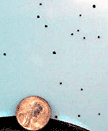Target Artillery Fungus
It makes a mess that will set you scrubbing
Artillery fungus is a microorganism that can create a mess on the exterior of your house. I have seen the clapboard on the first story of houses so covered with these millions of spores that the sides appeared gray.
Like dog vomit fungus [Bay Gardener, Vol. 15; issue 28: July 12, 2007] artillery fungus grows on raw, uncomposted wood mulch kept wet.
Hundreds of the fungus’ fruiting bodies may thrive on a piece of wood only a few inches long. Each of these fruiting bodies produces thousands of spores that can shoot eight to 10 feet into the air.
What’s worse, trying to brush off the spores with a broom will only smear them onto the siding, making it twice as difficult to remove. The only effective means to clean the siding is by using a stiff brush with soap and water, then rinsing with a hose. The longer the spores remain on the house, the more difficult they are to remove.
You’ll likely encounter artillery fungus as long as you use uncomposted mulch in the landscape. Only high-temperature composting of all wood waste can prevent this problem. And that’s just another good reason for using compost as your landscape mulch.
Strawberries Run Wild in New Brunswick
Q I have started two ever-bearing strawberry plant beds this summer. Now they have produced many runners, and I want to start a third bed. What is the proper procedure for severing the baby plants from the parent plant?
I have bark mulch on the strawberry beds, hoping this will keep the weeds down and retain moisture for the plants. I am noticing that the roots from the baby plants are not securing very well with the mulch. Do the baby plants have to be well secured into the ground before I snip them from the mother plant?
–Barb Walsh, Saint John, New Brunswick, Canada
A Remove the bark mulch because it is preventing the daughter plants from rooting. They must have firm contact with moist soil to root. Daughter plants that have rooted into the soil can be separated from the mother plants and transplanted into a new bed. This is best done in late August or September. Allow the daughter plants to establish a good root system before separating and digging.
By removing the mulch and making certain that the beds are irrigated twice weekly, you should have ample daughter plants to establish a third bed.
Ask Dr. Gouin your questions at [email protected]. All questions will appear in Bay Weekly. Please include your name and address.